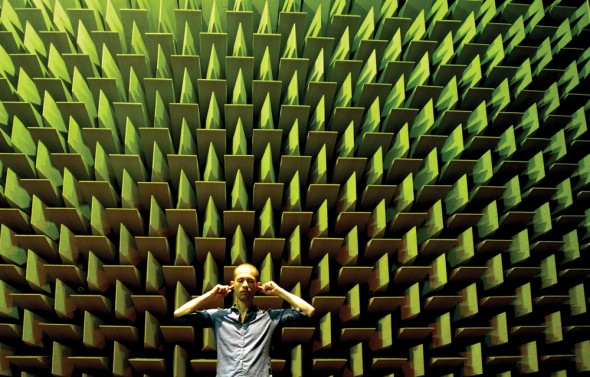
Photography Jacob Kirkegaard
Most people wouldn’t consider the “inner” sound of an iron fence musical or think to use low-amplitude frequencies to “play” the elements of a building. Nor would most people find it necessary to record the silence of an empty room, play the recording back into the room whilst recording it again, then repeat the process ten times over. Thankfully, for both the art and experimental sound world, Jacob Kirkegaard isn’t most people.
The Berlin-based artist, born in Denmark in the mid-’70s, has been working with unconventional sound recording since childhood, though the subject matter and methods have changed throughout his life.
“At school I recorded my friends, and at home I remember placing those walkie-talkie devices for kids in the other rooms so I could listen to my parents’ conversations,” recounts Kirkegaard. “I only started focusing on what I do today when I heard a radio feature in 1995 on Pierre Henry, the inventor of musique concrete. He inspired me to record my surroundings and then to put those sounds together into compositions.”
Still, it wasn’t until his early-’30s, while Kirkegaard studied at the Arts and Media College in Cologne, Germany, that he discovered the recording techniques that would help him design, and eventually define, his art. Instead of using a run-of-the-mill acoustic microphone, Kirkegaard began to experiment with special contact microphones that rely on a material’s vibrations, commonly known as accelerometers.
“That’s where the world of hidden and ‘inner’ sound opened for me,” he says. “Since then, I’ve been searching to explore discreet or unexpected sounds that live among and far from us.”
Projects such as “Eisenwind,” a recording of vibrations from water, wind, and passing ships along the iron fences surrounding the Rhine River, and “Loop Tower,” a live broadcast of sounds from the motions of wheels, wires, and other parts of the Berlin TV tower, possess a droning quality that can only be described as a symphony of metallic ghosts. Kirkegaard’s work is simultaneously industrial and a completely natural interaction with the elements of everyday life.
“I am very devoted to real sound, in contrast to synthetic sound, because of its many layers, noise, unpredictably, and life. Vibration is air pressure, and air pressure can often be heard as sound,” he says. “I’m interested in letting objects vibrate and to make sounds that way, so the sound isn’t coming from the loudspeaker, but from the material instead. I suppose that I am trying to be liberated from the speaker!”
When designing a project or building an installation, Jacob allows the work to define itself, while always remaining aware of how each part will interact. In a recent installation, entitled “Phonurgia Metallis,” he suspended three ultra-thin plates of copper, brass, and iron with contact microphones and essentially allowed them to “sing” to one another.
“I mirrored the natural vibration of the plates and made them vibrate into themselves and in their own sound,” he says. “The sounds vary because copper, for example, is heavier than brass. The installation is in the plates. The sound is in the plates. There are no conventional speakers or any extra sound. Only amplification and mirroring.”
Kirkegaard has a handful of like-minded peers, but none take the same sort of approach to creating their art. Whether documenting the sounds of the “Singing Sands” in the deserts of Oman, or digging through Iceland’s sonically rich volcanic earth, Kirkegaard is constantly uncovering the world’s hidden music with a conviction that borders on responsibility.
“Without me and my interaction, there wouldn’t be any sound; but, on the other hand, the resonance is already there somehow. We just can’t hear it.”
– Jacob Fallon

